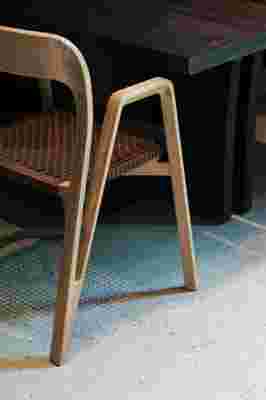At the southernmost tip of Norway , where sea storms from the north and south collide, scientists and foodies alike are celebrating the arrival of AD100 architecture firm Snøhetta 's latest project. What at first glance might look like the 112-foot-long (34-meter-long) remains of a concrete-and-wood barge tipped into the North Sea is actually Under, a new 3,230-square-foot restaurant that plunges 16 feet (five meters) into the rugged Lindesnes surf to give diners the experience of a lifetime: a meal up close and personal to the complex marine world at the seabed. Equipped with cameras and other surveillance equipment on its façade, and stable electric power and high-speed fiber-optic communication, the restaurant, which opened today for dinner as Europe's first underwater dining experience, also serves as a new study station for marine biologists, capable of both live and digital observation of the site's unique aquatic biodiversity.

The dining room of Under, a new underwater restaurant and marine biology station designed by Snøhetta at the southernmost tip of Norway.
The project is a result of months of site-specific research and collaboration with the science community, and restaurant owners Gaute and Stig Ubostad, who also run the adjacent Lindesnes Hav Hotel. In addition to "constructing a building that can withstand the pressure and shock from the rugged sea conditions for many years to come," explained Snøhetta project manager Rune Grasdal, careful consideration of the specific habitat of its aquatic neighbors was of extreme importance. A rectangular concrete shell with a large window at the submerged end is least obtrusive to sea life and most advantageous for observant diners and researchers. The architecture team hopes that, in time, this façade will be embraced by mollusks and kelp to become an artificial reef, as often is the case with traditional concrete seawalls.

The entrance of Under, in Norway, which plunges five meters into the North Sea.
The design experience is "holistic" yet "characterized by contrasts," says Grasdal, "between the landscape and the sea, above and below." The rough, industrial exterior is juxtaposed by a warm wood- and textile-filled interior: an oak-clad foyer and staircase welcome patrons down to the below-sea-level dining room, the transition also marked by a gradient of bespoke, fabric-covered acoustic panels on the ceiling, which mimic the colors of a sunset fading over the ocean: from the faintest blush to deep pink to sea blue to navy as one descends to Under's deepest point. There, patrons sit at Hamran tables and chairs, designed in collaboration with the architects. Head chef Nicolai Ellitsgaard has designed a sustainable menu with input from the station's marine biologists about how and when to harvest fish and seafood.

The Hamran furniture is bespoke and was designed in collaboration with Snøhetta.
A detail of the bespoke oak staircase and the gradient textile-covered ceiling leading to Under's main dining room.
In Scandinavia in particular, where crude oil is many of its nations' largest export, sustainability-minded clients and architects have tried to combat climate change at home through dual- or multipurpose structures. In Copenhagen, AD100 Bjarke Ingels Group will soon inaugurate its highly anticipated CopenHill ARC , a waste-to-energy power plant cum ski slope cum climbing wall whose smokestack technology has been years in the making (and its former scientist is at the forefront of a murderous global scandal ). Elsewhere in Norway, at the foot of the Holandsfjorden, Snøhetta is also in the works on Svart, the Arctic Circle's first net-positive hotel , a circular building on stilts in the water that creates a fishing hole with a surrounding boardwalk at its center.
In the conceptualization of these and other like projects, blurring the lines between design and scientific research has proven that smart structures are those that, resisting design gimmicks, can serve more than one function—and, as trends have it, for both public and private audiences—saving energy and resources in countries that experience extreme weather conditions.
In the case of Under, it is the science community that receives this secondary, yet equally important, benefit. And how has it fared so far? Quite well, says Grasdal: "Researchers have already discovered species of jellyfish that they did not know existed in the area, through the restaurant window."

Leave a Reply